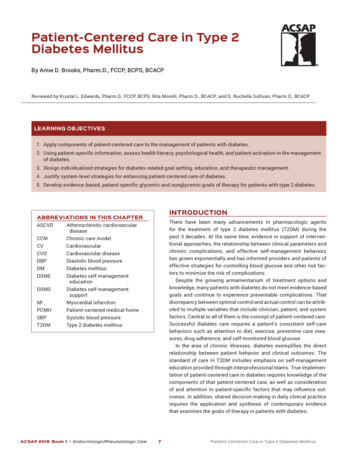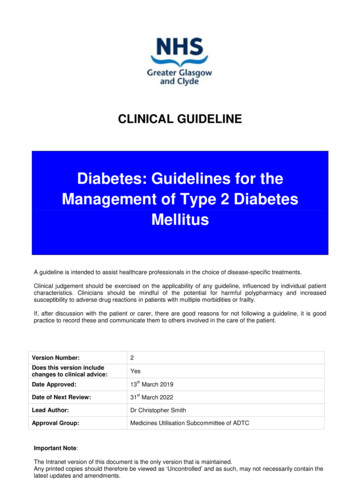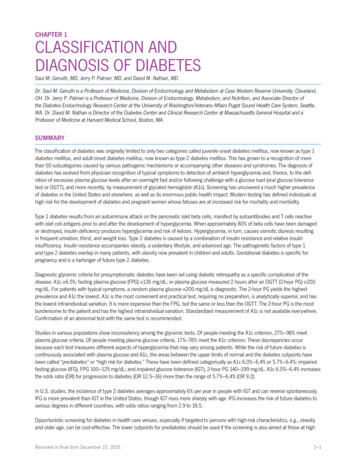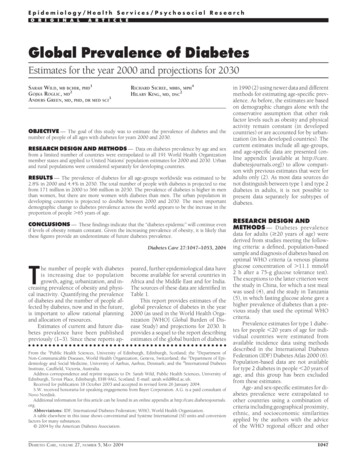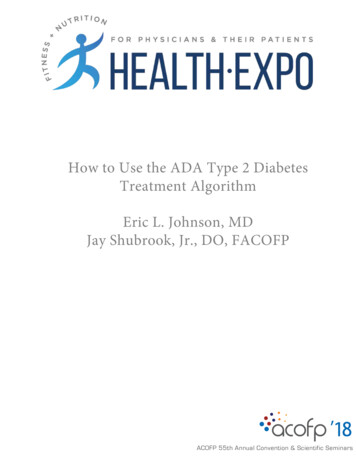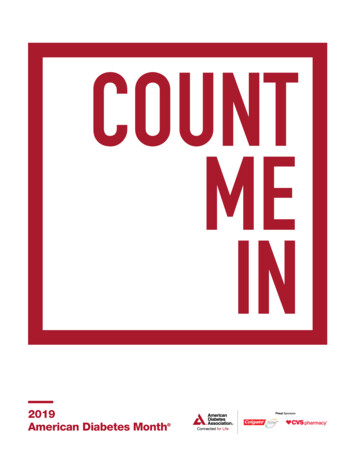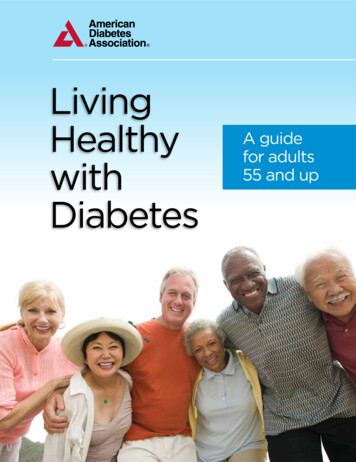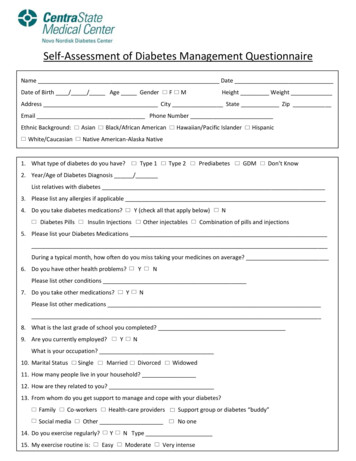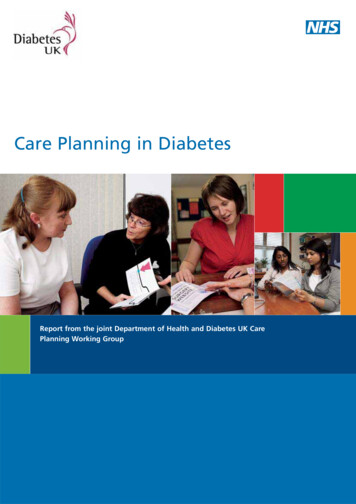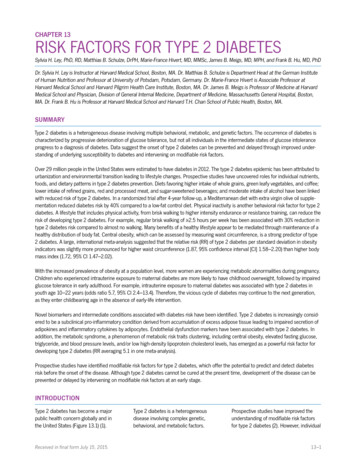
Transcription
Your Guide to Diabetes:Type 1 and Type 2National Diabetes InformationClearinghouse
Your Guide to Diabetes:Type 1 and Type 2
ContentsLearn about Diabetes. 1What is diabetes?. 2What is prediabetes?. 3What are the signs and symptomsof diabetes?. 4What kind of diabetes do you have?. 5Why do you need to take care ofyour diabetes?. 7Who is part of your health care team?. 8Take Care of Your Diabetes Each Day. 10Follow Your Healthy Eating Plan. 10Be Physically Active. 12Take Your Medicines as Prescribed. 16Monitor Your Diabetes. 21Keep Daily Records. 25Learn about High and Low BloodGlucose Levels. 26Prevent Diabetes Problems. 33
Take Care of Your Diabetes during SpecialTimes or Events. 36When You’re Sick. 36When You’re at School or Work. 39When You’re Away from Home. 41When You’re Flying on a Plane. 42When an Emergency or a Natural DisasterHappens. 45If You’re a Woman and Planninga Pregnancy. 46Your Diabetes Care Records. 48Points to Remember. 56Hope through Research. 61Pronunciation Guide. 63For More Information. 65Acknowledgments. 66
Learn about DiabetesYou can learn how to take care of your diabetes andprevent some of the serious problems diabetes can cause.The more you know, the better you can manage yourdiabetes.Share this booklet with your family and friends so they willunderstand more about diabetes. Also make sure to askyour health care team any questions you might have.You can learn how to take care of your diabetes.1
What is diabetes?Diabetes is when your blood glucose*, also called bloodsugar, is too high. Blood glucose is the main type of sugarfound in your blood and your main source of energy.Glucose comes from the food you eat and is also made inyour liver and muscles. Your blood carries glucose to all ofyour body’s cells to use for energy.Your pancreas—an organ, located between your stomachand spine, that helps with digestion—releases a hormone itmakes, called insulin, into your blood. Insulin helps yourblood carry glucose to all your body’s cells. Sometimes yourbody doesn’t make enough insulin or the insulin doesn’twork the way it should. Glucose then stays in your bloodand doesn’t reach your cells. Your blood glucose levels gettoo high and can cause diabetes or prediabetes.Over time, having too much glucose in your blood cancause health problems.*See the Pronunciation Guide for tips on how to say thewords in bold type.2
What is prediabetes?Prediabetes is when the amount of glucose in your bloodis above normal yet not high enough to be called diabetes.With prediabetes, your chances of getting type 2 diabetes,heart disease, and stroke are higher. With some weight lossand moderate physical activity, you can delay or preventtype 2 diabetes. You can even return to normal glucoselevels, possibly without taking any medicines.DiabetesPrediabetesCaution: Take steps to prevent type 2 diabetes now.Normal3
What are the signs and symptoms of diabetes?The signs and symptoms of diabetes are being very thirsty urinating often feeling very hungry feeling very tired losing weight without trying sores that heal slowly dry, itchy skin feelings of pins and needles in your feet losing feeling in your feet blurry eyesightSome people with diabetes don’t have any of these signs orsymptoms. The only way to know if you have diabetes is tohave your doctor do a blood test.4
What kind of diabetes do you have?The three main types of diabetes are type 1, type 2, andgestational diabetes. People can develop diabetes at anyage. Both women and men can develop diabetes.Type 1 DiabetesType 1 diabetes, which used to be called juvenile diabetes,develops most often in young people; however, type 1diabetes can also develop in adults. In type 1 diabetes, yourbody no longer makes insulin or enough insulin becausethe body’s immune system, which normally protects youfrom infection by getting rid of bacteria, viruses, and otherharmful substances, has attacked and destroyed the cellsthat make insulin.Treatment for type 1 diabetes includes taking shots, also called injections, of insulin. sometimes taking medicines by mouth. making healthy food choices. being physically active. controlling your blood pressure levels. Blood pressureis the force of blood flow inside your blood vessels. controlling your cholesterol levels. Cholesterol is atype of fat in your body’s cells, in your blood, and inmany foods.5
Type 2 DiabetesType 2 diabetes, which used to be called adult-onsetdiabetes, can affect people at any age, even children.However, type 2 diabetes develops most often in middleaged and older people. People who are overweight andinactive are also more likely to develop type 2 diabetes.Type 2 diabetes usually begins with insulin resistance—acondition that occurs when fat, muscle, and liver cells donot use insulin to carry glucose into the body’s cells to usefor energy. As a result, the body needs more insulin to helpglucose enter cells. At first, the pancreas keeps up withthe added demand by making more insulin. Over time, thepancreas doesn’t make enough insulin when blood sugarlevels increase, such as after meals. If your pancreas canno longer make enough insulin, you will need to treat yourtype 2 diabetes.Treatment for type 2 diabetes includes using diabetes medicines making healthy food choices being physically active controlling your blood pressure levels controlling your cholesterol levels6
Gestational DiabetesGestational diabetes can develop when a woman ispregnant. Pregnant women make hormones that can leadto insulin resistance. All women have insulin resistance latein their pregnancy. If the pancreas doesn’t make enoughinsulin during pregnancy, a woman develops gestationaldiabetes.Overweight or obese women have a higher chance ofgestational diabetes. Also, gaining too much weight duringpregnancy may increase your likelihood of developinggestational diabetes.Gestational diabetes most often goes away after the baby isborn. However, a woman who has had gestational diabetesis more likely to develop type 2 diabetes later in life. Babiesborn to mothers who had gestational diabetes are also morelikely to develop obesity and type 2 diabetes.Read more about diabetes and pregnancy inWhat I need to know about Gestational Diabetes atwww.diabetes.niddk.nih.gov.Why do you need to take care of your diabetes?Over time, diabetes can lead to serious problems with yourblood vessels, heart, nerves, kidneys, mouth, eyes, and feet.These problems can lead to an amputation, which is surgeryto remove a damaged toe, foot, or leg, for example.7
The most serious problem caused by diabetes is heartdisease. When you have diabetes, you are more than twiceas likely as people without diabetes to have heart disease ora stroke. With diabetes, you may not have the usual signsor symptoms of a heart attack. The best way to take care ofyour health is to work with your health care team to keepyour blood glucose, blood pressure, and cholesterol levelsin your target range. Targets are numbers you aim for.Who is part of your health care team?Most people with diabetes get care from primary careproviders, such as internists, family physicians, orpediatricians. A team of health care providers can alsoimprove your diabetes care.In addition to a primary care provider, your health careteam may include an endocrinologist for more specialized diabetes care a dietitian, a nurse, or a certified diabetes educator—experts who can provide information about managingdiabetes a counselor or mental health professional a pharmacist a dentist an ophthalmologist or an optometrist for eye care a podiatrist for foot care8
If diabetes makes you feel sad or angry, or if you have otherproblems that worry you, you should talk with a counseloror mental health professional. Your doctor or certifieddiabetes educator can help you find a counselor.Talk with your doctor about what vaccines andimmunizations, or shots, you should get to keep fromgetting sick. Preventing illness is an important part oftaking care of your diabetes.When you see members of your health care team, ask lotsof questions. Prepare a list of questions before your visit.Be sure you understand everything you need to know abouttaking care of your diabetes.When you see members of your health care team, asklots of questions. Prepare a list of questions beforeyour visit.9
Take Care of Your Diabetes Each DayDo four things each day to help your blood glucose levelsstay in your target range: Follow your healthy eating plan. Be physically active. Take your medicines as prescribed. Monitor your diabetes.These things may seem like a lot to do at first. Just makesmall changes until these steps become a normal part ofyour day.Follow Your Healthy Eating PlanAsk your doctor to give you the name of someone trainedto help you create a healthy eating plan, such as a dietitian.This plan, often called medical nutrition therapy, willinclude regular monitoring by your dietitian and educationabout how to adjust your eating habits as the need occurs.Medical nutrition therapy is usually covered by insurance orMedicare as long as your doctor refers you. Your dietitiancan help you plan meals that include foods that you andyour family like and that are good for you.10
Your healthy eating plan will include breads, cereals, rice, and whole grains fruits and vegetables meat and meat substitutes dairy products healthy fatsYour plan will also help you learn how to eat the rightamount, or portions, of food. Making good food choiceswill help you reach and stay at a healthy weight keep your blood glucose, blood pressure, andcholesterol levels under control prevent heart and blood vessel diseaseIf you take insulin, look at the white boxes like this one for“Action Steps.”Action StepsIf You Take Insulin Follow your healthy eating plan. Don’t skip meals, especially if you’ve already taken your insulin,because your blood glucose levels may drop too low. Learn more about how to handle low blood glucose, also calledhypoglycemia, in the section “Learn about High and Low BloodGlucose Levels.”11
If you don’t take insulin, look at the blue boxes like this onefor “Action Steps.”Action StepsIf You Don’t Take Insulin Follow your healthy eating plan. Don’t skip meals, especially if you take diabetes medicines,because your blood glucose levels may drop too low. Read more about how to handle low blood glucose, also calledhypoglycemia, in the section “Learn about High and Low BloodGlucose Levels.” Eat several small meals during the day instead of big meals.Read more about healthy eating plans in What I need to knowabout Eating and Diabetes at www.diabetes.niddk.nih.gov.Be Physically ActivePhysical activity helps you stay healthy. Physical activity isespecially good if you have diabetes because it helps you reach or stay at a healthy weight helps insulin work better to lower your blood glucoselevels is good for your heart and lungs gives you more energy12
Even small amounts of physical activity help managediabetes, such as when you are physically active at workor home. People with diabetes should aim for 30 to60 minutes of activity most days of the week. Children andadolescents with type 2 diabetes who are 10 to 17 years oldshould aim for 60 minutes of activity every day. Not allphysical activity has to take place at the same time.Increase daily activity by decreasing time spent watchingTV or at the computer. Children and adolescents shouldlimit screen time not related to school to less than 2 hours aday. Limiting screen time can help you meet your physicalactivity goal.People with diabetes should always talk with a doctor before starting a new physicalactivity program. do aerobic activities, such as brisk walking, which usethe body’s large muscles to make the heart beat faster.The large muscles are those of the upper and lowerarms and legs and those that control head, shoulder,and hip movements. do activities to strengthen muscles and bone, such assit-ups or lifting weights. Aim for two times a week. stretch to increase flexibility, lower stress, and helpprevent muscle soreness after physical activity.13
Many activities can help your child and your family stayactive and have fun. Consider activities that they mightenjoy and can stick with, such as playing basketball dancing to music with friends taking a walk or a bike ridePhysical activity helps youstay healthy.14
Action StepsIf You Take Insulin See your doctor before becoming physically active. Check your blood glucose levels before, during, and afterphysical activity. Don’t start a physical activity program whenyour blood glucose levels are high or if you have ketones inyour blood or urine. Read more about ketones in the section“Monitor Your Diabetes.” Don’t be physically active right before you go to bed because itcould cause low blood glucose while you sleep.Action StepsIf You Don’t Take Insulin See your doctor before becoming physically active. Ask your doctor about whether you need to eat before you arephysically active.When you are being physically active, carry glucose tabletsor a carbohydrate-rich snack or drink with you, such as fruitor juice, in case your blood glucose levels go too low.Read more about increasing your physical activity in WhatI need to know about Physical Activity and Diabetes atwww.diabetes.niddk.nih.gov.15
Take Your Medicines as PrescribedIf you have type 2 diabetes and are unable to reach yourtarget blood glucose levels with a healthy eating plan andphysical activity, diabetes medicines may help. Your doctormay prescribe you diabetes medicines that work best foryou and your lifestyle.If you have type 1 diabetes, you need insulin shots if yourbody has stopped making insulin or if it doesn’t makeenough. Some people with type 2 diabetes or gestationaldiabetes also need to take insulin shots.If you have type 2 diabetes and are unableto reach your target blood glucose levelswith a healthy eating plan and physicalactivity, diabetes medicines may help.16
Diabetes MedicinesMost people with type 2 diabetes use medicines other thaninsulin shots. People with type 2 diabetes use medicine tohelp their blood glucose levels stay in their target range. Ifyour body makes insulin and the insulin doesn’t lower yourblood glucose levels enough, you may need to take one ormore medicines.Diabetes medicines come in pill and shot form. Somepeople take diabetes medicines once a day and othermedicines more often. Ask your health care team when youshould take your diabetes medicines. Sometimes, peoplewho take diabetes medicines may also need insulin shots fora while.Be sure to tell your doctor if your medicines make you feelsick or if you have any other problems. If you get sick orhave surgery, your diabetes medicines may no longer workto lower your blood glucose levels. Always check with yourdoctor before you stop taking your diabetes medicines.17
Insulin ShotsOnly a doctor can prescribe insulin. Your doctor can tellyou how much insulin you should take and which of thefollowing ways to take insulin is best for you: Insulin shot. You’ll use a needle attached to asyringe—a hollow tube with a plunger—that you fillwith a dose of insulin. Some people use an insulinpen, a penlike device with a needle and a cartridge ofinsulin. Never share insulin needles or insulin pens,even with family. Insulin pump. An insulin pump is a small device filledwith insulin that you wear on your belt or keep in yourpocket. The pump connects to a small, plastic tubeand a small needle. You or your doctor inserts theneedle under your skin. The needle can stay in forseveral days. Insulin jet injector. This device sends a fine spray ofinsulin through your skin with high-pressure air insteadof a needle.18
Insulin injection port. You or your doctor inserts asmall tube just beneath your skin, where it remains inplace for several days. You can inject insulin into theend of the tube instead of through your skin.Read more about ways to take insulin in Alternative Devicesfor Taking Insulin at www.diabetes.niddk.nih.gov.Only a doctor can prescribe insulin. Yourdoctor can tell you how much insulin youshould take.19
Other MedicinesYour doctor may prescribe other medicines to help withproblems related to diabetes, such as aspirin for heart health cholesterol-lowering medicines medicines for high blood pressureRemembering to take your medicines at the correct timeseach day can be challenging. Many people find thatkeeping a weekly pill box with separate boxes for each day,and even separate boxes for morning and evening, canhelp. Also ask your health care team to update your list ofmedicines at each visit so you always have an accurate list ofwhat medicines to take and when.Read more about diabetes and medicines inWhat I need to know about Diabetes Medicines atwww.diabetes.niddk.nih.gov.20
Monitor Your DiabetesCheck Your Blood Glucose LevelsChecking and recording your blood glucose levels can helpyou monitor and better manage your diabetes. If your bloodhas too much or too little glucose, you may need a change inyour healthy eating plan, physical activity plan, or medicines.A member of your health care team will show you howto check your blood glucose levels using a blood glucosemeter. Your health care team can teach you how to prick your finger to get a drop of blood for testing use your meter to find out your blood glucose levelfrom your drop of bloodRead more in Continuous Glucose Monitoring atwww.diabetes.niddk.nih.gov.Your health insurance or Medicare may pay for the bloodglucose meter and test strips you need.Checking and recording your blood glucoselevels can help you better manage your diabetes.21
Ask your doctor how often you should check your bloodglucose levels. You may need to check before and aftereating, before and after physical activity, before bed, andsometimes in the middle of the night. Make sure to keep arecord of your blood glucose self-checks.Target Range for Blood Glucose LevelsMost people with diabetes should try to keep their bloodglucose levels as close as possible to the level of someonewho doesn’t have diabetes. This normal target range isabout 70 to 130. The closer to normal your blood glucoselevels are, the lower your chance of developing serioushealth problems.Ask your doctor what your target levels are and when youshould check your blood glucose levels with a meter. Makecopies of the chart in the section “Your Diabetes CareRecords” to take with you when you visit your doctor.Reaching your target range all of the time can be hard.Remember, the closer you get to your target range, thebetter you will feel.The A1C TestAnother test for blood glucose, the A1C—also called thehemoglobin A1C test, HbA1C, or glycohemoglobin test—isa blood test that reflects the average level of glucose in yourblood during the past 2 to 3 months.22
You should have the A1C test at least twice a year. If yourresult is not on target, your doctor may have you take thetest more often to see if your A1C improves.For the test, your doctor will draw a sample of your bloodduring an office visit or send you to a lab to have your blooddrawn. Your A1C test result is given as a percentage. YourA1C result plus the record of your blood glucose numbersshow whether your blood glucose levels are under control. If your A1C result is too high, you may need to changeyour diabetes treatment plan. Your health care teamcan help you decide what part of your plan to change. If your A1C result is on target, then your diabetestreatment plan is working. The lower your A1C result,the lower your chance of having diabetes problems.Talk with your doctor about what your A1C target shouldbe. Your personal target may be above or below the targetshown in the chart.A1C TargetsTarget for most people with diabetesBelow 7 percentTime to change my diabetes care plan8 percent or above23
A1C targets can also depend on how long you have had diabetes whether or not you have other health problemsRead more about A1C targets at www.ndep.nih.gov.Tests for KetonesYou may need to check your blood or urine for ketones ifyou’re sick or if your blood glucose levels are above 240.Your body makes ketones when you burn fat instead ofglucose for energy. If you have too many ketones, you aremore likely to have a serious condition called ketoacidosis.If not treated, ketoacidosis can cause death.Signs of ketoacidosis are vomiting weakness fast breathing sweet-smelling breathKetoacidosis is more likely in people with type 1 diabetes.Your doctor or diabetes educator will show you how to testfor ketones.24
Keep Daily RecordsMake copies of the daily diabetes record at the end of thisbooklet. Then, write down the results of your blood glucosechecks each day. You may also want to record what youate, how you felt, and whether you were physically active.Bring your blood glucose records to all visits with yourhealth care team. They can use your records to see whetheryou need changes in your diabetes medicines or in yourhealthy eating plan.Action StepsIf You Take InsulinKeep a daily record of your blood glucose levels the times of day you take insulin the amount and type of insulin you take what types of physical activity you do and for how long when and what you eat whether you have ketones in your blood or urine when you are sickAction StepsIf You Don’t Take InsulinKeep a daily record of your blood glucose levels the times of day you take your medicines what types of physical activity you do and for how long25
Learn about High and Low Blood Glucose LevelsSometimes, no matter how hard you try to keep your bloodglucose levels in your target range, they will be too high ortoo low. Blood glucose that’s too high or too low can makeyou feel sick. If you try to control your high or low bloodglucose and can’t, you may become even sicker and needhelp. Talk with your doctor to learn how to handle theseemergencies.Learn about High Blood Glucose LevelsIf your blood glucose levels stay above 180 for more than1 to 2 hours, they may be too high. See the chart onpage 54. High blood glucose, also called hyperglycemia,means you don’t have enough insulin in your body. Highblood glucose can happen if you miss taking your diabetes medicines eat too much don’t get enough physical activity have an infection get sick are stressed take medicines that can cause high blood glucose26
Be sure to tell your doctor about other medicines you take.When you’re sick, be sure to check your blood glucoselevels and keep taking your diabetes medicines. Read moreabout how to take care of yourself when you’re sick in thesection “Take Care of Your Diabetes during Special Timesor Events.”Signs that your blood glucose levels may be too high are thefollowing: feeling thirsty feeling weak or tired headaches urinating often having trouble paying attention blurry vision yeast infectionsVery high blood glucose may also make you feel sick toyour stomach.If your blood glucose levels are high much of the time, or ifyou have symptoms of high blood glucose, call your doctor.You may need a change in your healthy eating plan,physical activity plan, or medicines.27
Learn about Low Blood Glucose LevelsIf your blood glucose levels drop below 70, you have lowblood glucose, also called hypoglycemia. Low bloodglucose can come on fast and can be caused by taking too much diabetes medicine missing or delaying a meal being more physically active than usual drinking alcoholic beveragesSometimes, medicines you take for other health problemscan cause your blood glucose levels to drop.Signs your blood glucose levels may be too low are thefollowing: hunger dizziness or shakiness confusion being pale sweating more weakness anxiety or moodiness headaches a fast heartbeat28
If your blood glucose levels drop lower, you could havesevere hypoglycemia, where you pass out or have a seizure.A seizure occurs when cells in the brain release a rushof energy that can cause changes in behavior or musclecontractions. Some seizures are life threatening.If you have any of these symptoms, check your bloodglucose levels. If your blood glucose levels are less than 70,have one of the following right away: three or four glucose tablets one serving of glucose gel—the amount equal to15 grams of carbohydrates 1/2 cup, or 4 ounces, of fruit juice 1/2 cup, or 4 ounces, of a regular—nondiet—soft drink 1 cup, or 8 ounces, of milk five or six pieces of hard candy 1 tablespoon of sugar, syrup, or honey29
Have one of these foods ordrinks when your blood glucoselevels are low.After 15 minutes, check your blood glucose levels again.Repeat these steps until your blood glucose levels are 70 orabove. If it will be at least 1 hour before your next meal,eat a snack.If you take diabetes medicines that can cause low bloodglucose, always carry food for emergencies. You shouldalso wear a medical identification bracelet or necklace thatsays you have diabetes.30
If you take insulin, keep a prescription glucagon kit athome and at other places where you often go. A glucagonkit has a vial of glucagon, a syringe, and a needle to injectthe glucagon. Given as a shot, the glucagon quickly raisesblood glucose. If you have severe hypoglycemia, you’llneed someone to help bring your blood glucose levels backto normal by giving you a glucagon shot. Show your family,friends, and coworkers how to give you a glucagon shotwhen you have severe hypoglycemia. Someone should call911 for help if a glucagon kit is not available.Action StepsIf You Take Insulin Tell your doctor if you have low blood glucose, especially at thesame time of the day or night, several times in a row. Tell your doctor if you’ve passed out from low blood glucose. Ask your doctor about glucagon. Glucagon is a medicine thatraises blood glucose. Show your family, friends, and coworkers how to give you aglucagon shot when you have severe hypoglycemia. When you have severe hypoglycemia, someone should call 911for help if a glucagon shot is not available.31
Action StepsIf You Don’t Take Insulin Tell your doctor if you have low blood glucose, especially at thesame time of the day or night, several times in a row. Tell your doctor about other medicines you are taking. Ask your doctor whether your diabetes medicines might causelow blood glucose.Read more about low blood glucose in Hypoglycemia atwww.diabetes.niddk.nih.gov.Tell your doctor if you have low bloodglucose, especially at the same time of dayor night, several times in a row.32
Prevent Diabetes ProblemsTaking care of your diabetes every day will help your bloodglucose, blood pressure, and cholesterol levels stay inyour target ranges. Caring for your diabetes can also helpprevent other health problems over the years. You can doa lot to prevent diabetes problems: Follow your healthy eating plan every day. Be physically active every day.33
Take your medicines every day. Check your blood glucose levels every day.34
Types of Diabetes ProblemsDiabetes problems can damage parts of the body such as the heart blood vessels eyes kidneys nervesHeart and blood vessel disease can lead to heart attacksand strokes. Nerve damage can lead to a loss of feeling inthe feet, which may lead to an amputation. You will wantto take steps to prevent these diabetes problems.Read more about preventing diabetes problems in thefollowing booklets at www.diabetes.niddk.nih.gov. Thesebooklets are also available in Spanish and large-printversions: Prevent diabetes problems: Keep your diabetes undercontrol Prevent diabetes problems: Keep your eyes healthy Prevent diabetes problems: Keep your feet healthy Prevent diabetes problems: Keep your heart and bloodvessels healthy Prevent diabetes problems: Keep your kidneys healthy Prevent diabetes problems: Keep your mouth healthy Prevent diabetes problems: Keep your nervous systemhealthy35
Take Care of Your Diabetes during SpecialTimes or EventsDiabetes is part of your life. You can learn how to takecare of yourself and your diabetes when you’re sick, whenyou’re at school or work, when you’re away from home,when an emergency or a natural disaster happens, or whenyou’re thinking about having a baby or are pregnant.When You’re SickHaving a cold, the flu, or an infection can raise your bloodglucose levels. Being sick puts stress on your body. Yourbody releases hormones to deal with the stress
controlling your cholesterol levels. Cholesterol is a type of fat in your body’s cells, in your blood, and in many foods. 6 Type 2 Diabetes Type 2 diabetes, which used to be called adult-ons
